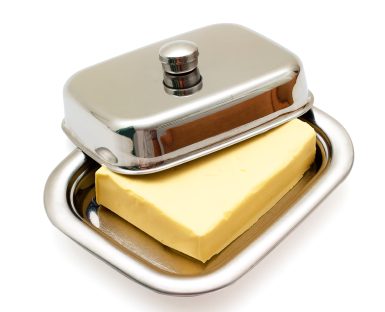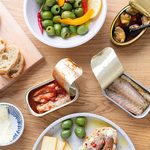Diet tips from the 19th century
For one week, I tried cooking 19th-century recipes. Here’s how it went

Source: Best Health Magazine, March/April 2010
Here is some intriguing advice for entertaining that I found in an early Canadian cookbook: ‘If you have company when you are unprepared, rennet pudding may be made at five minutes’ notice, if you have calf’s rennet soaked
in a bottle of wine; one glass of this wine will make a sort of cold custard.’
Yum. Nowadays, when guests pop in, we offer them Ruffles and dip. In the 19th century, they got a cow’s stomach lining. I know this because I recently tried to cook and eat for a week as if in a time warp. I’d been wondering what would happen if for some reason our global food distribution networks seized up‘what would one do? What local foods were available in a Canadian winter, and how would one prepare them?
Locavores of the 19th century
To orient myself, I went to visit Campbell House Museum in Toronto, which is the preserved home of an early 19th-century local family. Curator Liz Driver took me to see the kitchen, which had a hearth big enough to store a snowmobile in. It was huge. Driver explained that fire would be kept going in this hearth pretty much 24-7, with various cast iron pots of numerous sizes and widths positioned above and beside the flames.
Hogs and other animals were killed in late autumn, when the weather made it safer to preserve the meat. From then until spring it would be, as Canadian pioneer author Catharine Parr Traill noted, ‘meat thrice a day.’
Olive oil, oranges and lemons could have been (and were) imported by the wealthier citizens, Driver said, but ‘whoever you were, your diet was also very much affected by the seasons. People wrote in their diaries, ‘Oh God, not pork again.”’
Root vegetables were buried in tubs of sand in the cellar, and could last through to February. A book I found advised boring holes in apples with a goose quill and filling them with sugar so they would last until Christmas. As for ways to preserve eggs, you could smear them with butter to plug up the pores of their shells, or immerse them in a mush of powdered rock lime, cream of tartar, water and salt.
The luxury of pureed soup
For further tips, Driver suggested some cookery books from the period: The Cook Not Mad, or Rational Cookery and The Frugal Housewife’s Manual. She recommended a soup made with turnip, potatoes, onions and carrots. ‘Purées were special,’ she said. A smooth soup was a luxury because it was so time-consuming to press cooked vegetables through a colander. This I confirmed when it took me 45 minutes to bash boiled turnips through my sieve with the back of a wooden spoon. Add cream and some cayenne pepper, and you have a delicious dinner that positively screams for a blender.
Browsing the books, I skipped the recipes for Pigeons on Toast, and Macaroni and Kidneys. I pondered making fruitcake with suet, which is the fat surrounding a cow’s kidneys, but my vegetarian son got alarmed.
So I started with the basics: bread and butter. First, note to the wise: Never attempt to make your own bread and your own butter on the same afternoon unless you have tensor bandages on both wrists. The exercise one gets’shaking cream, kneading dough’is commendable, to say the least.
Second, don’t believe cookbooks that airily declare your dough will double in size if stored in a warm, draft-free place. No it won’t. It will just sit there like a sullen lump, behaving as if it had never met yeast in its life and doesn’t know what you want it to do. I tried this three times, on each occasion fiddling with the temperature and humidity and amount of kneading involved, to no avail. I baked it anyway, and my family enjoyed unleavened bread.
Homemade butter’surprisingly easy
Butter, on the other hand, was surprisingly simple to make. I bought a container of organic whipping cream, purloined an empty pickle jar, filled it halfway, and shook it. After five minutes, I had made whipped cream, which was a revelation in itself. So much easier than beating it in a big bowl! Resume shaking for the duration of an
episode of Friends, and hurrah, the cream separates into a thin, translucent buttermilk’and a ball of yellow butter. I felt extremely pleased, as if I’d successfully conducted a chemistry experiment.
Now, what to do with my butter? According to Catharine Parr Traill, whose life took her from living as landed gentry in Regency England to bushwhacking in the forests of Ontario, the best breakfast was buckwheat pancakes. The flour is made by grinding up the seed of a buckwheat plant, which isn’t a grain’it’s related to rhubarb. Buckwheat is dark, somewhat nutty in taste, and high in protein, fibre and vitamins. Its ability to lower blood sugar (crucial for people with diabetes) is being investigated by nutritionists. You can buy buckwheat flour in the organic section of supermarkets. I ate the pancakes for breakfast all week, topped with my butter and some local honey.
One lunch involved cold pork (not pork again!); another was a mince of boiled potato, cabbage and corned beef, which I made by slow-roasting brisket.
Failed experiments
Not everything I made was edible, to be honest. The recipes don’t bother with precise measurements. You use ‘a handful of flour’ here, ‘a bit of butter’ there. Put ‘all into a spider’ and bake four hours. (Spiders were three-legged pans.) Many foods were slow-cooked at a distance from the flames, which can take a long time. (I couldn’t exactly keep a fire burning all day in my townhouse fireplace, so I used my gas oven.) Moreover, the recipes created jumbo-sized batches, so my house was quickly overflowing with Tupperware containers of Indian Pudding (cornmeal, molasses and milk) and Baked Beans (which I undercooked, despite soaking the beans overnight).
I balked at making my own yeast, which called for a pound of flour, a quarter pound of sugar and two gallons of water; after all, yeast actually became commercially available in the 1860s. Before that, just imagine going through yet another giant concocting process on a given day.
I found that what one begins to yearn for is fruit juice, cucumbers and crunchy things. With wrinkled apples and wilted parsnips I’d been storing since October, and desserts on offer like balls of boiled rice with sugar, taste begins wanting. Back then, an orange for Christmas would, indeed, have been a gift. Imagine the joy of spring, then, when the first crisp fiddleheads and pea shoots came to table. Perhaps I’ll try this again in May.
This article was originally titled "The 100-Year-Old Diet," in the March/April 2010 issue of Best Health. Subscribe today to get the full Best Health experience’and never miss an issue!’and make sure to check out what’s new in the latest issue of Best Health.




